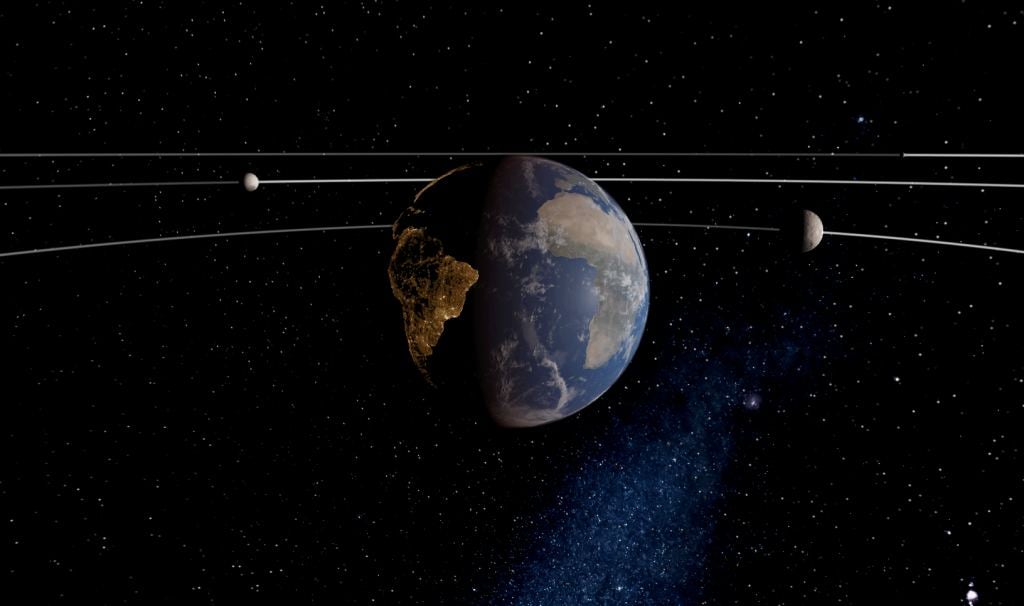In a recent study published in *Earth and Planetary Astrophysics*, a team of researchers from the University of Texas at Arlington, Valdosta State University, Georgia Institute of Technology, and the National Radio Astronomy Observatory estimated how many moons could theoretically orbit the Earth while maintaining present conditions such as orbital stability. This study opens the potential for better understanding planetary formation processes which could also be applied to identifying exomoons possibly orbiting Earth-like exoplanets, as well.
"In an earlier work, I examined planet packing for the Alpha Centauri binary," said Dr. Billy Quarles, an Assistant Professor of Astronomy and Astrophysics at Valdosta State University, and a co-author on the study. "In that case, I developed an estimate for the number of planets that could exist within each star's habitable zone. In that scenario, the habitable zone provided natural boundary conditions, where I was able to use the same dynamical formalism for the problem of moons (using the Earth-Sun system as a binary). To define the outer boundary, one of my coauthors developed a scheme that we could use. Combining these ideas, we expected that >10 Ceres-, 6 Pluto-, and 4 Luna-sized objects would be possible (i.e., Table 2 from our paper)."
While there are over 200 moons in our solar system, only three orbit terrestrial (rocky) planets: our Moon (Luna) around the Earth, and Phobos and Deimos around Mars. The remaining 200+ moons orbit all the gas giants, to include Jupiter, Saturn, Uranus, and Neptune. As the study notes, this large difference is expected since "they experience different formation mechanisms and orbital evolution processes." The study discusses how the maximum allowable number of moons that could exist around Earth depends on the assumed sizes of the moons themselves. In this case, the researchers used Ceres-, Pluto-, and Luna-sized objects to determine how many of each could successfully orbit the Earth. The results showed that orbital stability could be maintained with satellites up to 7 ± 1 Ceres-mass, 4 ± 1 Pluto-mass, and 3 ± 1 Luna-mass moons.
"The surprise was that the lower mass prototypes were more limited, which we ascribe to their increased scattering probability (from a lower inertia)," said Quarles. "The perturbations from neighboring moons are enough to cause substantial scattering within a few thousand years. We had to reduce the number of moons to account for this."
As seen with Jupiter's Galilean Moons, small satellites orbiting a much larger planetary body can result in what's known as tidal heating, where the constant stretching and compressing the much smaller satellite experiences leads to interesting results, to include volcanism on Io and an interior ocean on Europa. But could a multi-moon system with Earth experience these same results, as well?
"Tidal heating of the moons themselves may be possible, but it is unclear to the extent of the heating without performing detailed simulations," said Dr. Quarles. "It is tempting to suggest that the innermost moon could resemble Io, but its tidal heating is in part due to mean motion resonances with the other Galilean moons. In our systems, mean motion resonances largely destabilize the satellite system because the Sun adds to each moon's eccentricity growth and eventual scatter."
Along with the potential for tidal heating, this study also potentially broadens the search for exomoons that orbit exoplanets. Unfortunately, while the number of confirmed exoplanets is in the thousands, the number of confirmed exomoons is currently less than a fraction of that number.
"Currently we have 2 exomoon candidates (Kepler-1625b-i and Kepler-1708b-i), but their respective host planet is similar to Jupiter," said Dr. Quarles. "The candidate moons are also both larger than the Earth. These more exotic cases may be easier to identify in a similar way Hot Jupiters were easier to spot over smaller planets in the early days of exoplanets. However, multiple planet systems were discovered soon after the first bone-fide exoplanets. We expect something similar for exomoons. When we have multiple candidate exomoons orbiting the same planet, then our work will have more utility. The constraints we find are pretty optimistic, where more realistic conditions will probably limit the number of moons further. In photometric measurements, background objects could mimic the transit signal of a candidate exomoon, and our work gives a physical basis to constrain the number of expected moons when testing different hypotheses."
Dr. Suman Satyal, an Adjunct Assistant Professor of Physics at the University of Texas at Arlington and lead author on the study, said that since Earth can have more than one moon, this "increases the probability" of detecting exomoons. "This should give an idea to exomoon observers the upper limit of the number of moons around Earth-mass planet orbiting Sun-like star," he said.
How many exomoons are there in the cosmos, and is there an Earth-like exoplanet with multiple exomoons capable of supporting life? Only time will tell, and this is why we science!
As always, keep doing science & keep looking up!
 Universe Today
Universe Today

